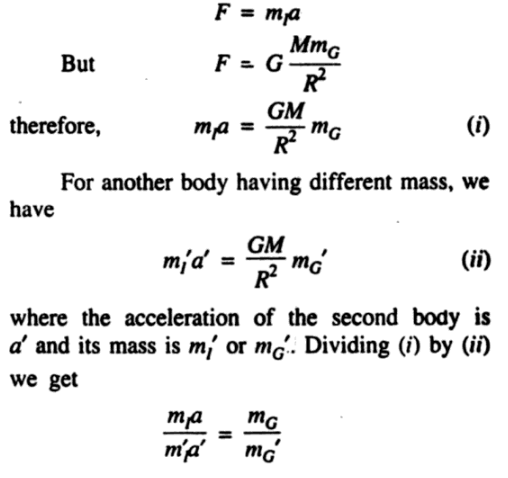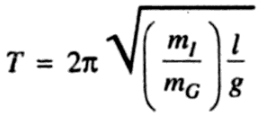Inertial and Gravitational Mass:
Inertial Mass- From Newton’s second law of motion we know that
| F = mla |
Where ‘F’ is the force applied and ‘a’ is the acceleration produced in a body of mass ml. For a fixed value of force, the acceleration generated is determined by the mass- the larger the value of ml smaller the acceleration produced. The mass ml defined above is called inertial mass, for it is a measure of the body’s resistance to acceleration. Thus, inertial mass is a measure of the inertia of the body and is given by the ratio of the force applied to the acceleration produced.
Gravitational Mass- However, the mass of a body that is most familiar to us is what is known as gravitational mass. We know that the gravitational pull on an object is strictly proportional to its mass mG i.e., the pull due to another object of mass M at a distance R is given by

Where the constant of proportionality between the pull F and mass mG has been written as g. The mass so defined is known as the gravitational mass and g is known as the intensity of the gravitational field. Thus, the gravitation mass of a body is that which determines the gravitational pull acting on it in the gravitational field.
Comparison Between ml and mG:
In order to measure the mass by an equal-arm balance, a body is placed on one pan, and equal mass in the shape of standard unit masses is placed on the other so that the pull on both sides of the balance may be equal. It is to be noted that by such a procedure we are comparing the pull of gravity and we are infact comparing or measuring the gravitational mass of the body. Thus gravitational mass is something that determines what would be the force due to the attraction of the earth.
Once we know the force, what would be the acceleration produced simply depends on the inertial mass of the body? The inertial mass is a measure of its reluctance to change the state of motion and as such it is a dynamic property. On the other hand, gravitational mass is a quantity that determines the force that a body experiences when it is in a gravitational field. Since gravitational mass and inertial mass are measured in quite different ways, it appears as if they have no connection with each other. However, both of them are related as shown below:
Equality of Two Masses: In order to decide whether the inertial and gravitational masses are one and the same thing or different, we note that a body falls under the gravitational pull, then

But experiments show that in a vacuum, all bodies fall freely with the same acceleration i.e, a = a’ = g, hence
| ml/ml‘ = mG/mG‘ |
The above analysis shows that the inertial mass and gravitational mass are proportional to each other. To check the equivalence of two masses Newton performed experiments with a simple pendulum. It can be shown that the time period of a simple pendulum of length l is given by

Newton measured T by filling a hollow bob of a simple pendulum with different substances having the same gravitational mass mG and with a possibility of different values of inertial mass ml. But he always got the same value of T, meaning thereby that ml = mG. Hence, both the inertial and gravitational mass of a given body are equal.









Comments (No)